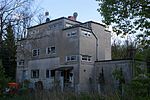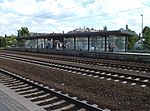Berlin Albrechtshof station
Accuracy disputes from March 2022Berlin S-Bahn stationsBerlin railway station stubsBuildings and structures in SpandauRailway stations in Berlin ... and 2 more
Railway stations in Germany opened in 1943Wikipedia page with obscure subdivision

Berlin Albrechtshof is a railway station located in Staaken, a locality in the Spandau district of Berlin. It is one of only two Deutsche Bahn stations in Berlin not served by the S-Bahn; Staaken station is the other.
Excerpt from the Wikipedia article Berlin Albrechtshof station (License: CC BY-SA 3.0, Authors, Images).Berlin Albrechtshof station
Seegefelder Weg, Berlin Staaken
Geographical coordinates (GPS) Address Nearby Places Show on map
Geographical coordinates (GPS)
| Latitude | Longitude |
|---|---|
| N 52.549444444444 ° | E 13.128333333333 ° |
Address
Albrechtshof
Seegefelder Weg
13591 Berlin, Staaken
Germany
Open on Google Maps









